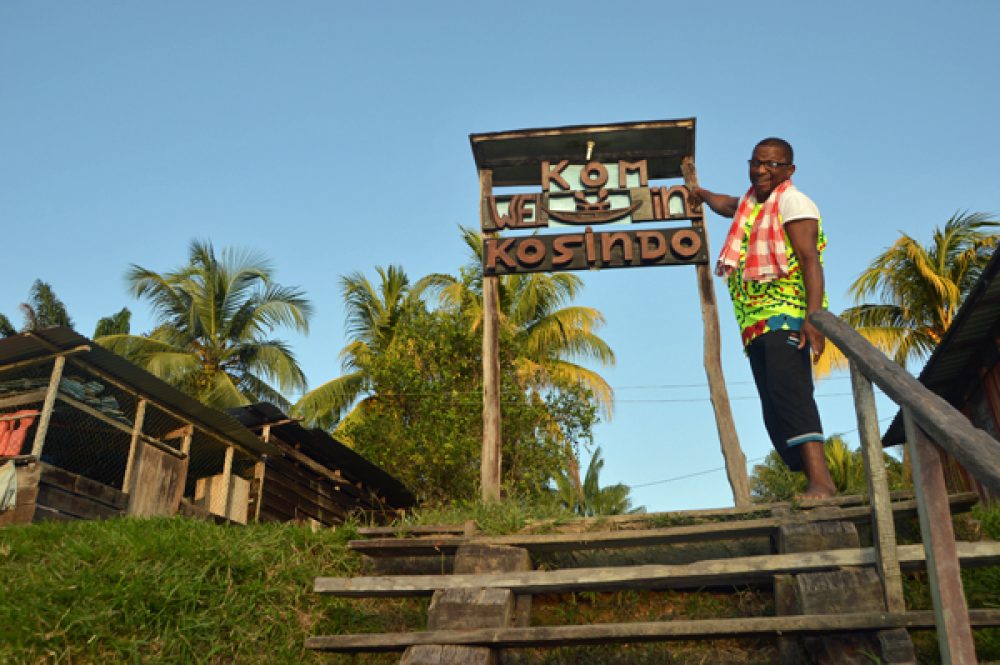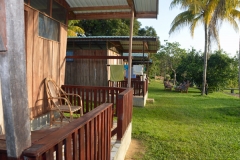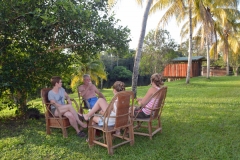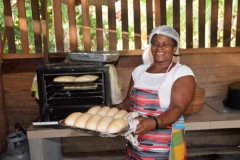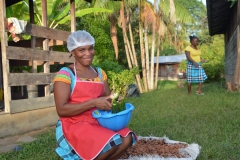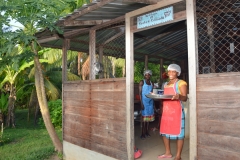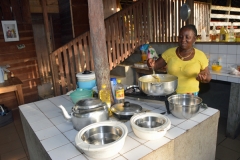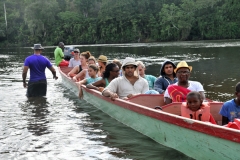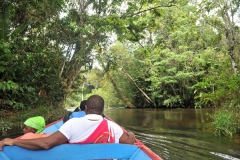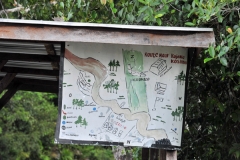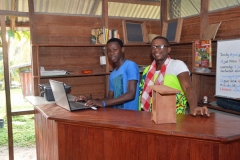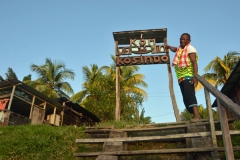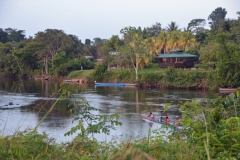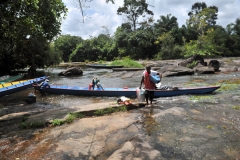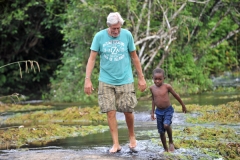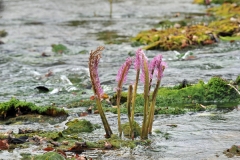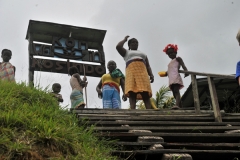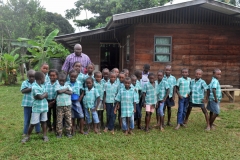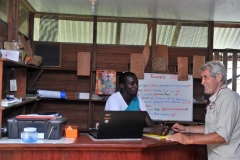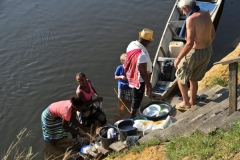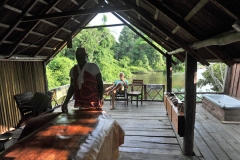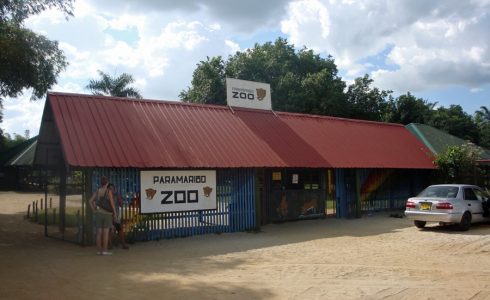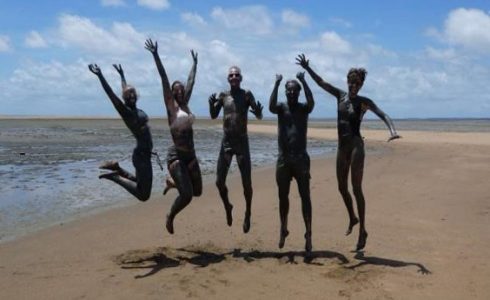Kosindo River Lodge has cabins with private shower and toilet. But there is an essential difference compared to the other lodges along the Upper Suriname River and Gran Rio: here you are not on an island, here you are not separated by water from the village and its inhabitants, here you are not dependent on a canoe which you transfer, here you do not have to wait for a group tour to visit the village Kajana and the environment.
Besides Kajana is so much further south than the other tourist lodges along the Upper Suriname River, the lifestyle of the Maroons there remained much more original.
Kosindo River Lodge and the original Saramaccan village Kajana form one unit. The lodge is right on the Gran Rio River and Kajana borders the Lodge. Women of the village doing laundry in the river at the lodge, children swimming at Kosindo’s welcome gate, villagers come to buy fresh bread in the bakery. In the majestic Amazon rainforest you will experience in the Dutch language is an active introduction to the culture and people of the village. In Kajana and five other interconnected through forest trails, villages along the Upper Suriname River / Gran Rio, keeping the hunting grounds of the villages and there are fewer disturbances by the sound of the canoes. More chance to see birds and other wildlife and hear. Surrounded by the mighty Amazon Jungle and you set yourself know in this kind Saramaccan village community: it is the unique Kosindo.
Outbound from Atjoni is upstream, and may take a whole day (about 6 hours). Sometimes you have to road overnight with low water. Small groups sail with Lanti Boto (a line boat with a fixed price pp.) between Atjoni and Tapawatra, sometimes to Gran Dam; further to or from Kosindo by lodge charter.This charter price is divided by the number of passengers, so the larger the group, the lower the price.
Don’t forget: food and drinks (which you can buy at Atjoni), long sleeves, 3/4 trousers, sandals you can wade with, shawl or towel to protect your neck against the sun, sun hat, total screen sun lotion, sun glasses, light plastic rain cape directly at hand against sudden showers. All electronic equipment and documents must be packed waterproof. You have to defy two impressive obstacles on the way. The boatsmen can tell you heroic stories about vicissitudes while taking those obstacles, which ended well, or less well! Tu-lio-buka (‘two-river-mouth’) where the Gran Rio and the Pikin Rio merge into the Upper Surinam, with the Tapawatra rapid, the occlusion (‘tapa’) of the Gran Rio, is unforgettable. Sailing half an hour further on the Gran Rio/Gaan Lio, you moor at Gran Dam (Gaan Dan in Saramaccan), the second big rapid. That one forms a magnificent island with a unique vegetation. For the second time the canoe is unloaded and towed at some distance over the rocks and over land. Carrying the bagage and towing the boat is done by the boatsmen, but who feels up to it may help. Only for strong men and women! Then it’s only 3 quarters of an hour more to Kosindo River Lodge.
Including excursion village walk:
The different Saramaccan villages of the Langu region are connected by footpaths. All Saramaccan villages, houses, and fields in the Langu region – except one you cannot visit – are situated on the same side of the river.
For this guided walk you go by boat to one of the villages first. You can choose which villages you want to visit. At Moitori you can visit the woodcarving and the sewing workshops. The local system of small-scale agriculture on the so-called ‘cost grounds’ is explained to you. Some houses with their shiny polished cookware are a feast for the eyes. An other village next to Kayana is Ligorio, a still very authentic Saramaccan village with a Roman Catholic church and churchyard; the only cemetary this side of the river. We walk through a piece of marvellous river wood, with small creeks and bridges.
Stonhuku is the chief town of the Langu region. Some 250 people are living there, as well as the head captain of the region. Occasionally you can pay him a visit with the guide. You will be amazed by the Saramaccan hospitality!From Stonhuku you walk to the north through a magnificent landscape; there you pass the hamlets Godowata and Deböö. Especially the sacrificial sites with beautifully stylised wooden statues are remarkable in those villages. Your guide is sure to explain the function of those statues. A bit further you reach Kayana again!
Including excursion walking in the rainforest:
On the other side of the Gran Rio we walk through the pristine Amazon Rain Forest. Along the river we see a hut or field here and there, but when you go a bit further all you see is secundary and primary rain forest. It’s so marvellous to discover a fluttering stark blue morpho butterfly along the creek. Just enjoy the ferns and the evergreen bushes. Pause a while to observe a colourful beetle on a leaf. Or, who knows, you might surprise an aguti (gold hare) …
To make this trip you are taken to the other side of the river by canoe. You go on an expedition along small pathways through the tropical rain forest with your guide, who will draw your attention to parasol ants, sluggards, and the typical sounds of the forest. This is your occasion to enjoy the rich biodiversity at a leisurely pace in a region still pristine, with hardly any trace of human presence. Nature as it has been for ages!
Including excursion wood carving:
Kosindo River Lodge has a small wood shop where children learn how to process wood according to ancient traditions. How e.g. to make stools and oars and how to decorate them with notches. You can also participate half a day and learn how to apply beautiful notches in soft cedar wood.
Including excursion traditional kitchen and gourd decoration:
Come and lend a hand in the 3 traditional kitchens of Kosindo River Lodge: the bakery, the rice kitchen, and the general kitchen. As you’ll see, there’s plenty of tasty and healthy food at the lodge!
You can e.g. help to prepare traditional meals based on cassave or coco, and why not of a delicious Surinam saoto soup.
On the premises of the lodge, gourds are decorated. Let’s go and pick some. We’re going to boil them, and then you can use all your creativity to apply traditional decorations, together with the kitchen staff.

